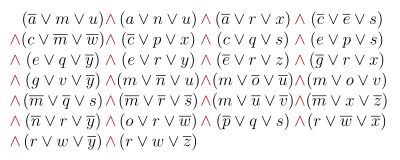
Back مسألة كثيرة حدود غير قطعية كاملة Arabic NP-tam məsələ AZ NP-complet Catalan NP-úplnost Czech NP-komplet Danish NP-Vollständigkeit German NP-completeness Greek NP-completo Spanish انپی کامل FA NP-täydellisyys Finnish
This article may be confusing or unclear to readers. (July 2012) |

In computational complexity theory, a problem is NP-complete when:
- It is a decision problem, meaning that for any input to the problem, the output is either "yes" or "no".
- When the answer is "yes", this can be demonstrated through the existence of a short (polynomial length) solution.
- The correctness of each solution can be verified quickly (namely, in polynomial time) and a brute-force search algorithm can find a solution by trying all possible solutions.
- The problem can be used to simulate every other problem for which we can verify quickly that a solution is correct. In this sense, NP-complete problems are the hardest of the problems to which solutions can be verified quickly. If we could find solutions of some NP-complete problem quickly, we could quickly find the solutions of every other problem to which a given solution can be easily verified.
The name "NP-complete" is short for "nondeterministic polynomial-time complete". In this name, "nondeterministic" refers to nondeterministic Turing machines, a way of mathematically formalizing the idea of a brute-force search algorithm. Polynomial time refers to an amount of time that is considered "quick" for a deterministic algorithm to check a single solution, or for a nondeterministic Turing machine to perform the whole search. "Complete" refers to the property of being able to simulate everything in the same complexity class.
More precisely, each input to the problem should be associated with a set of solutions of polynomial length, the validity of each of which can be tested quickly (in polynomial time),[2] such that the output for any input is "yes" if the solution set is non-empty and "no" if it is empty. The complexity class of problems of this form is called NP, an abbreviation for "nondeterministic polynomial time". A problem is said to be NP-hard if everything in NP can be transformed in polynomial time into it even though it may not be in NP. A problem is NP-complete if it is both in NP and NP-hard. The NP-complete problems represent the hardest problems in NP. If some NP-complete problem has a polynomial time algorithm, all problems in NP do. The set of NP-complete problems is often denoted by NP-C or NPC.
Although a solution to an NP-complete problem can be verified "quickly", there is no known way to find a solution quickly. That is, the time required to solve the problem using any currently known algorithm increases rapidly as the size of the problem grows. As a consequence, determining whether it is possible to solve these problems quickly, called the P versus NP problem, is one of the fundamental unsolved problems in computer science today.
While a method for computing the solutions to NP-complete problems quickly remains undiscovered, computer scientists and programmers still frequently encounter NP-complete problems. NP-complete problems are often addressed by using heuristic methods and approximation algorithms.
- ^ For example, simply assigning true to each variable renders the 18th conjunct (and hence the complete formula) false.
- ^ Cobham, Alan (1965). "The intrinsic computational difficulty of functions". Proc. Logic, Methodology, and Philosophy of Science II. North Holland.
